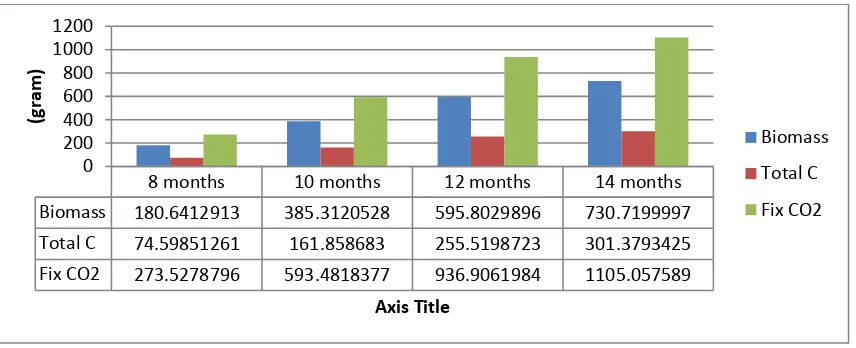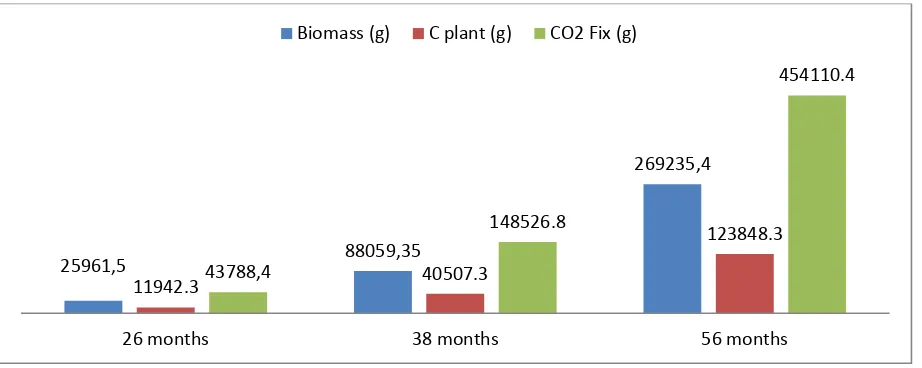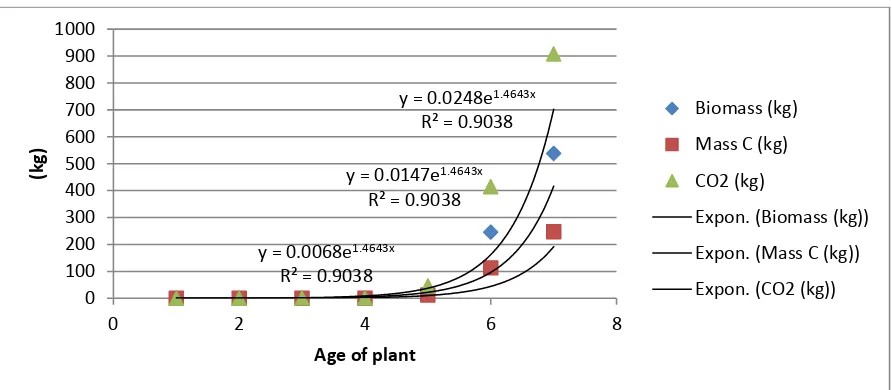1 ESTIMATING CO2 FIXATION CAPACITY AT EARLY GROWTH OF OIL PALM
IN PEAT SOIL
Prayitno, M.B1,2)., Sabaruddin3), D. Setyawan3) and Yakup3)
1) Post Graduate Student, Agric. Sci, Fac of Agric, Sriwijaya University, Indonesia.
2) Lecture, Soil Sci. Dept., Fac. of Agric, Sriwijaya University, Indonesia.
E-mail: prayitno_muhbambang@yahoo.com. Mobile Phone: 081373291625.
3) Lecture, Faculty of Agriculture, Sriwijaya University, Palembang, Indonesia.
ABSTRACT
Increasing number and area of oil palm plantation in peat soil. South Sumatra need certain attention in relation to environmental changes. Planting oil palm in abondoned and degraded peat soil is expected to reduce further degradation due to fires. Current research was conducted in PT Gading Cempaka Oil Palm Plantation Area, Ogan Komering Ilir District, South Sumatra Province, and starting from October 2012 to February 2013. Winrock Equation and World Agroforestry Centre field practice were used consecutively to determine total number of sampling sites and to measure some parameters on oil palm. Result of research showed that Biomass of oil palm plant at the ages 8, 10, 12 and 14 months are 180.64 g, 385.31 g, 595.80 g and 730.72 g. CO2 fixation at the same age are respectively 273.53; 593.48; 936.91 and 1105.06
grams per plant. The highest biomass at the samet age are respectively on the stem, trunk, stems and stems. Biomass at the age of 26 to 56 months are 25.961 up to 269.235 kg per plant or approximately 3.375 to 35.001 tons per ha. Carbon sequestration ranged from 11.942 to 123.848 kg C per plant, equivalent to 1.553 to 16.11 tonnes C per ha. Ability of CO2 fixation in plants
aged 26, 38 and 56 months are ranged from 43.788 to 454.110 kg CO2 e per plant, equivalent to
5,692 up to 59.034 tons CO2 e per ha. The age of plant has a significant effect on plant biomass
(y = 0.024 e 1.4643 x, R2 = 0.9038), carbon mass (y = 0.014 e 1, 4643x, R2 = 0.9038) and CO2
fixation (y = 0.0068 e 1,4643x, R2 = 0.9038). Key word: oil palm plantation, peat soil, CO2.
INTRODUCTION
Utilization of natural resources in South Sumatra and no control excessive peat swamp forests in particular is an impact on the creation of degraded lands. This condition will continue to decline in the quality of land and also the environment, either by natural or human activities. On the other hand, the government is less able to manage the land for the better condition.
Peatland area in Indonesia around 22.5 million hectares (Central Kalimantan Peatlands Project Consortium, 2008) or approximately 265,500 km2 (14% of Indonesia's land area) (Joosten, 2009). South Sumatra province has around
1.4 million ha peat land.
Most of the peatlands have been degraded and exploited by people and companies for agricultural and forestry activities.Peatlands in Indonesia, which has been converted and used for farming, forestry, and mining account for about 20% (Rieley et al., 1996). Hooijer et al., (2006) estimated at about 1.3 % per year of natural peat forest has been converted to other uses since 1985 to 2000.
South Sumatra peatlands are mostly topogen peat deposits on the lowlands east coast, with a distribution is in the OKI (500,000 ha), Muba (250,000 ha), Banyuasin (200,000 ha), Muara Enim (45,000 ha) and Musi Rawas (35,000 ha) (South Sumatra Forest Fire Management Project, 2005), and the majority of peatlands is in a degraded land.
2 Development of oil palm hectarage in the year 2006-2008 has been given permission is opening in West Kalimantan peatland area of 706,379.1 ha, an area of 239,388.93 ha Central Kalimantan and Riau area of 792,618.08 ha (Sawit Watch Official Web Site, 2009) .
Agroforestry management of oil palm on peat land has several positive and negative impacts on the environment and society. The positif impacts are able to improve the ability of the land to be a productive land, reducing the incidence of fires, being able to increase the income of the peopl/government and potential to impove carbon uptake by palnt of oil palm. On the other hand, the negative impacts are a change in the ecosystem from natural vegetation (heterogeneous types) to plantation plants (homogenous type), carbon loss during the opening and land management activities.
METERIALS AND METHODS
This study is part of dissertation research on “the carbon balance of oil palm agroforestry in peat land”. The study was conducted on the Palm Oil Plantation of PT Gading Cempaka Graha, Ogan Komering Ilir Region, South Sumatra Province, from October 2012 to April 2013.
The method of measuring the carbon plant consists of destructive and non-destructive methods. The destructive method was used for plant age 8, 10, 12 and 14 months (plants in the nursery) and the non-destructive method was used for the plant life of 26, 38 and 56 months (plants in the field). Variable observations carried out in accordance with the method of measuring carbon (destructive or non-destructive method). Carbon analysis performed in a laboratory plant SEMEO Biotrop Bogor.
Number of sample plots for each plant is determined by using the Winrock equation. The result of Winrock equation calculation show that for the sample aged 56 months comprising 2 plot (Block 05D and 06D), aged 36 months consisting of 2 plots (Block 09D and 10D) and the age of 26 months consisting of 1 plot (Block 25A).Parameters for the biomass calculation of plant oil palm was referring to the World Agroforestry Centre field practice.
RESULTS AND DISCUSION
Carbon stocks in above ground is a living part of plants (biomass) that grows on a landscape (Hairiah and Murdiyarso (2007). Plant life is one of the main sources of carbon. Increase the amount of carbon will be in harmony with the age of the plant, including oil palm plantations.
The main source of above ground biomass carbon reserves on palm oil plantation is a plant oil palm, which starts from young plant in the nursery untill old plant (25 years in the field). However, now days the oil palm plantations on peatland cultivated especially in South Sumatra are mostly just old about 3 to 4 years.
PT Gading Cempaka is one of oil palm plantations in peat landscapes of OKI district. The oldest palm plant is about 56 months and have started to bear fruit, and the youngest plant is 26 months old. Oil palm seedlings are derived from his own nursery and also from other companies around South Sumatra Province.
1. Carbon Sequestration Palm Oil Plant at the age of 8, 10, 12 dan 14 months
Plant biomass is the result of photosynthesis and it can be used to determine the carbon sequestration in plants. Hairiah and Rahayu (2007) stated that the potential carbon mass can be approximated by measuring biomass stands, and the magnitude of the mass of carbon is strongly influenced by age and biomass plants.
The result of biomass plant measurement at the age of 8, 10, 12 and 14 months on each part of the plant is presented in Figure 1. Biomass plants in leaf, stem, stems and roots have different weight on each plant age.
3 (stem), and at the age of 14 months is 206.7 g or 31.62% (stem). Highest carbon mass on the stem because most of the carbon is the main constituent stem wall (Hilmi, 2003).
Total plant biomass on plant age 8, 10, 12 and 14 months are respectively 180.64 g, 385.31 g, 595.80 g and 730.72 g and the addition of biomass with increasing age of the plant.
Figure 1. Plant Biomass in every part of palm oil plant at the age of 8, 10, 12 and 14 months.
The relationship between plant biomass, carbon mass and CO2 fixation (Figure 2)
show that increasing age of the plant will be followed by increasing plant biomass, carbon mass and CO2 fixation. CO2 fixation at the age of 8, 10, 12 and 14 months were respectively 273.53;
593.48; 936.91 and 1105.06 grams per plant.
Figure 2. The relationships between biomass, carbon mass and CO2 fixation of palm oil plant at
the age of 8, 10, 12 and 14 months
2. Carbon sequestration Palm Oil Plant at the age of 26, 38 and 56 months
Biomass distribution of oil palm in each sample plant and plant plots (Figure 3) shows a high diversity. Biomass plant will increase with the increasing age of the plant. Growth of plants in the nursery is very dependent on the applied fertilizer treatment. On the other hand the growth of plant in the field is dependent on fertilizer treatment and also soil characteristics. So, the growth of plants in the field are moslty to be better in response to the land.
8 months 10 months 12 months 14 months
leaf 45.63043478 54.55 157.3037975 165.2409639
trunk 50.78 143.983871 161.04375 231.1082251
stem 41.46341463 116.16 180.0166667 206.7536232
root 42.76744186 70.61818182 97.43877551 127.6171875
0 50 100 150 200 250
(g)
Age
leaf
trunk
stem
root
8 months 10 months 12 months 14 months
Biomass 180.6412913 385.3120528 595.8029896 730.7199997
Total C 74.59851261 161.858683 255.5198723 301.3793425
Fix CO2 273.5278796 593.4818377 936.9061984 1105.057589
0 200 400 600 800 1000 1200
(gr
am)
Axis Title
Biomass
Total C
4 Average content of biomass, carbon mass and CO2 fixation capacity of the plant at the
age of 26, 38 and 56 months are presented in Figure 4. Figure 4 shows an increasing rate of biomass, carbass on and CO2 fixation with increasing age of the plant.
Figure 3. Biomass distribusion of oil palm plant at the age of 26, 38 and 56 months
Figure 4. The relationship between biomass, carbon mass and CO2 fixation of palm oil plant at
the age of 26, 38 and 56 months
Biomass values at the age of 26 to 56 months is around 25.961 up to 269.235 kg per plant or approximately 3.375 to 35.001 tons per ha. The research by Yulianti (2009) shows that oil palm at the age of 1, 2 and 9 years have dry biomass of 1.28; 1.83 and 22.09 tons per ha respectively.
The ability of oil palm plantations could sequester carbon shows in Figure 4. Figure 4 has ranged between 11.942 to 123.848 kg C per plant or equal to 1,553 up to 16.11 tonnes C per ha. Oil palm plantations in Indonesia were able to save an average of about 5 Mg C per ha (Lasco, 2002) and in Malaysia around 46.4 tonnes per ha (Henson, 1999).
Carbon biomass will continue to increase with increasing age, and the maximum at age 19-24 years with a carbon content of 27.168 tons per ha (Henson, 1999). Furthermore Tjitrosemito and Mawardi (2001) suggested that oil palm at age 19 years has a carbon content of approximately 40.28 tons per ha. Activities of oil palm plantations on peatland is able to sequester carbon about 100 tons per ha in the period 15 to 25 years (Agus, 2007).
0 100 200 300 400 500
0 5 10 15 20 25 30
(kg)
(Plant Sampel)
Plant Biomass
26/25A
38/09D
38/10D
56/05D
56/06D
25961,5 88059,35
269235,4
11942.3 40507.3
123848.3
43788,4
148526.8
454110.4
26 months 38 months 56 months
5 Ability of CO2 fixation by plant oil palm (Figure 4) ranged from 43.788 to 454.110 kg
COe per plant, equivalent to 5,692 up to 59.034 tons CO2 e per ha.
Relationship between the age of plant with biomass, carbon mass and CO2 fixation at
the age of 8, 10, 12, 14, 26, 38 and 56 months shows in Figure 5 and 6. Figure 5 shows that the biomass, the mass of carbon and CO2 fixation tend to increase with increasing age of the plant.
Figure 6 shows has a significant effect on plant biomass (y=0,024 e 1,4643x, R2= 0,9038) carbon
mass (y= 0,014 e1,4643x , R2= 0,9038) and fixation CO
2 (y=0,0068 e 1,4643x, R2= 0,9038).
Figure 5. The relationship between age of the plant with biomass, carbon mass and CO2 fixation of the palm oil plant at the age of 8, 10, 12, 14, 26, 38 and 56 months
Figure 6. The relationship between age of the plant with biomass, carbon mass and CO2 fixation of the palm oil plant at the age of 8, 10, 12, 14, 26, 38 and 56 months
CONCLUSIONS
1. Biomass of oil palm plant at the ages 8, 10, 12 and 14 months are 180.64 g, 385.31 g, 595.80 g and 730.72 g. CO2 fixation at the same age are respectively 273.53; 593.48; 936.91
and 1105.06 grams per plant.
2. Highest biomass of oil palm at the age 8, 10, 12 and 14 are respectively on the stem, trunk, stems and stems. Biomass tend to increase with increasing age of the plant.
3. Biomass at the age of 26 to 56 months are 25.961 up to 269.235 kg per plant or approximately 3.375 to 35.001 tons per ha. Carbon sequestration ranged from 11.942 to 123.848 kg C per plant, equivalent to 1.553 to 16.11 tonnes C per ha.
8 months 10 months 12 months 14 months 26 months 38 months 56 months
Biomass (kg) 0.18 0.34 0.6 0.73 27.09 245.91 538.47
Mass C (kg) 0.08 0.16 0.27 0.34 12.46 113.12 247.7
CO2 (kg) 0.3 0.57 1.01 1.23 45.69 414.77 908.22
6 4. Ability of CO2 fixation in plants aged 26, 38 and 56 months are ranged from 43.788 to
454.110 kg CO2 e per plant, equivalent to 5,692 up to 59.034 tons CO2 e per ha.
5. The age of plant has a significant effect on plant biomass (y = 0.024 e 1.4643 x, R2 = 0.9038),
carbon mass (y = 0.014 e 1, 4643x, R2 = 0.9038) and CO
2 fixation (y = 0.0068 e 1,4643x, R2 =
0.9038).
ACKNOWLEDGEMENTS
Thanks addressed: firstly to the Rector of Sriwijaya University, who has given permission to study in a doktoral program; secondly to Director General of Higher Education Ministry of Education and Culture, which has provided scholarships BPS; and thirdly to PT Gading Cempaka Graha who has given permission and all fasilities during the research.
REFERENCES
Agus F. 2007. Cadangan, emisi, dan konservasi karbon pada lahan gambut. Bunga Rampai Konservasi Tanah dan Air. Pengurus Pusat Masyarakat Konservasi Tanah dan Air Indonesia 2004-2007. Hal. 45 – 52.
Hairiah K, dan Rahayu S. 2007. Pengukuran ‘Karbon Tersimpan’ di berbagai Macam Penggunaan Lahan. Bogor. World Agroforestry Centre - ICRAF, SEA Regional Office, University of Brawijaya, Unibraw, Indonesia.
Henson, I . 1999. Comparative Ecophysiology of Oil Palm and Tropical Rain Forest. Oil Palm and The Environment - A Malaysian Perspective . In Gurmit, S; Lim, K H; Teo Leng and Lee Kow eds. Malaysian Oil Palm Growers Council, Kuala Lumpur. p. 9-39. Hilmi E. 2003. Model pendugaan kandungan karbon pada pohon kelompok jenis Rhizophora
spp. Bruguierai spp dalam tegakan hutan mangrove di Indragiri Hilir Riau. [Disertasi]. Bogor: Program Pascasarjana, Institut Pertanian Bogor
Hooijer A, Silvius M, Wosten M, Page S. 2006. PEAT-CO2, Assessment of CO2 Emission From Drained Peatlands in SE Asia. Wetland International and Delft Hydraulics Report. Http://www.wetlands.org. Diunduh pada 13 November 2009.
Joosten H. 2009. Peatland status and drainage related emissions in all countries of the world. The Global Peatland CO2 Picture. Wetlands International. www.wetlands.org. 35p. Komisi Pengawas Persaingan Usaha Republik Indonesia. 2007.Evaluasi Kebijakan Perkebunan
Kelapa Sawit. Position paper KKPU terhadap Perkembangan Perkebunan Kelepa Sawit.
Konsorsium Central Kalimantan Peatlands Project. 2008.
Lasco. R.D. 2002 Forest Carbon Budgets in Southeast Asia Following Harvesting and Land Cover Change. Science in China. Vol 45 supp Oktober 2002. p 55-64.
Rieley, J.O., A.A. Ahmad-Shah, dan M.A. Brady. 1996. The extent and nature of tropical peat swamps. in E. Maltby, C.P. Immirzi, dan R.J. Safford (eds.), Tropical Lowland Peatlands of Southeast Asia, Proceedings of a Workshop on Integrated Planning and Management of Tropical Lowland Peatlands, IUCN, Gland, Switzerland, 17–53. Sawit Watch Official Web Site (Generated: 6 March, 2009, 13:46)
South Sumatra Forest Fire Management Project. 2005. Sistem Informasi Kebakaran Hutan dan Lahan. Tidak Dipbulkikasikan.
World Agroforestry Centre. 2009. Petunjuk Teknis Lapangan Pengambilan Data Primer untuk Mencari Jejak Karbon dari Produksi Biofuel Kelapa Sawit. Pengukuran Cadangan Karbon Tingkat Plot di Lahan Kelapa Sawit.


